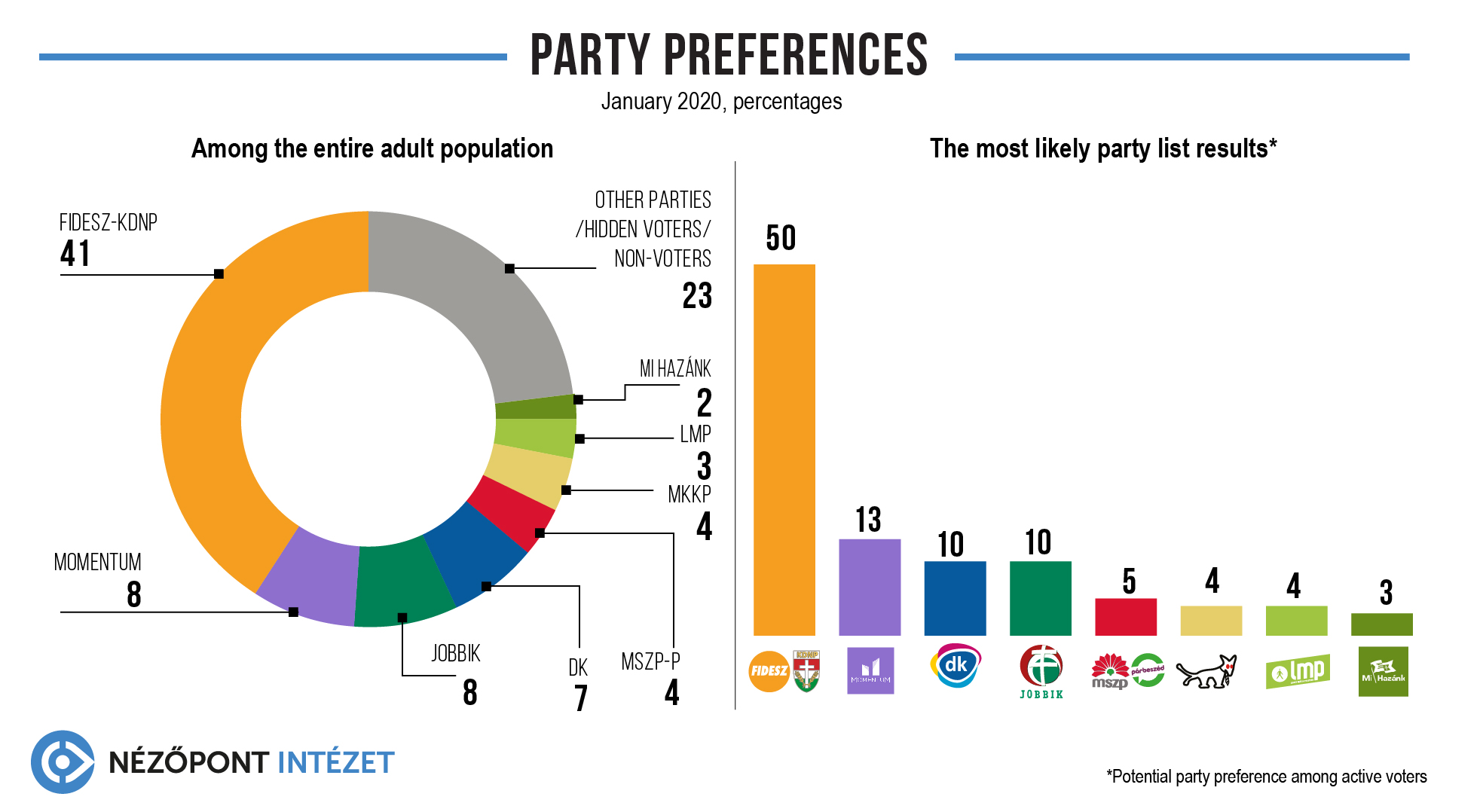50 per cent of the decided voters would choose the national list of Fidesz-KDNP in an election held this Sunday. While the governing parties retained their popularity, Momentum grabbed the lead among the opposition parties, as they are supported by 13 per cent of the active voters. Jobbik and DK came in at 10 per cent each, according to the representative public opinion poll conducted by Nézőpont Intézet.

Fidesz-KDNP could get 50 per cent of the votes cast in a poll this Sunday. The high popularity of the governing parties has remained stable, with every other active voter (50 per cent) being their symphatizer in January 2020. The candidate of Fidesz-KDNP won the mayoral re-election in Győr by a comfortable majority, yet it is clear that the governing parties would win an actual election by a large margin. The support of the opposition parties has been stagnating since the local elections, and any variance was due to the activity among their voters.
Of the opposition parties, Momentum would be able to get 13 per cent on the list if the elections were held this Sunday. This political platform, which has no parliamentary representation in Hungary, gained a 3 point lead ahead of Ferenc Gyurcsány’s party, the Democatic Coalition (Demokratikus Koalíció) and Jobbik, which is now led by its new president, Péter Jakab, both parties standing at 10 per cent. Based on the size of its voter camp (5 per cent), the MSZP-P alliance still could not pass the 10 per cent threshold for the joint listing of the two parties. What is more, their support has declined to the extent that none of the parties would be able to win a seat on its own as MSZP stands at 4 per cent, Párbeszéd stands at 1 per cent among those who would vote in the election. Some of the opposition parties have similar concerns: the Hungarian Two-Tailed Dog Party (Magyar Kétfarkú Kutya Párt) and LMP have 4 per cent support, while Our Hungary Movement (Mi Hazánk Mozgalom) could receive 3 per cent on the list this Sunday.
The research data suggest that the opposition parties would not be able to win the election with two or even one common list. A common list of the seven potential opposition platforms (Momentum Movement, DK, Jobbik, MSZP-P, MKKP, LMP) could not reach 50 per cent, the rate gained by Fidesz. Moreover, the support of a common opposition list might be lower than the total accumulated ratio of each individual party’s support.
| Fidesz KDNP |
Momentum Mozgalom | DK | Jobbik | MSZP P |
MKKP | LMP | Mi Hazánk | |
| Total population | 41 | 8 | 7 | 8 | 4 | 4 | 3 | 2 |
| Active voters | 49 | 11 | 9 | 8 | 4 | 4 | 3 | 3 |
| The most likely party list results | 50 | 13 | 10 | 10 | 5 | 4 | 4 | 3 |
Among the entire population, Fidesz-KDNP has strong support with 41 per cent, as no other political movement was able to reach two-digit results, apart from the governing parties. In this category the gains of Momentum have vanished, which shows that although the party’s sympatizers are active, their proportion in the entire population is the same as in the case of Jobbik (8 per cent), and even DK is just 1 per cent behind in this dimension. MSZP-P and MKKP stand at 4 per cent each, LMP has 3 per cent, while Our Hungary Movement (Mi Hazánk mozgalom) has 2 per cent of the votes among the entire population.
From January 2020 Nézőpont Intézet is introducing the following new methodology in conducting its public opinion polls: the poll was based on phone interviews of 1000 persons, between 10-16 January 2020. The sample is representative of the 18+ population by gender, age, region, settlement type and level of education. A sample of 1000 at 95 per cent accuracy has a 3.16 per cent margin of error.
Cover photo: MTI / Balázs Mohai
